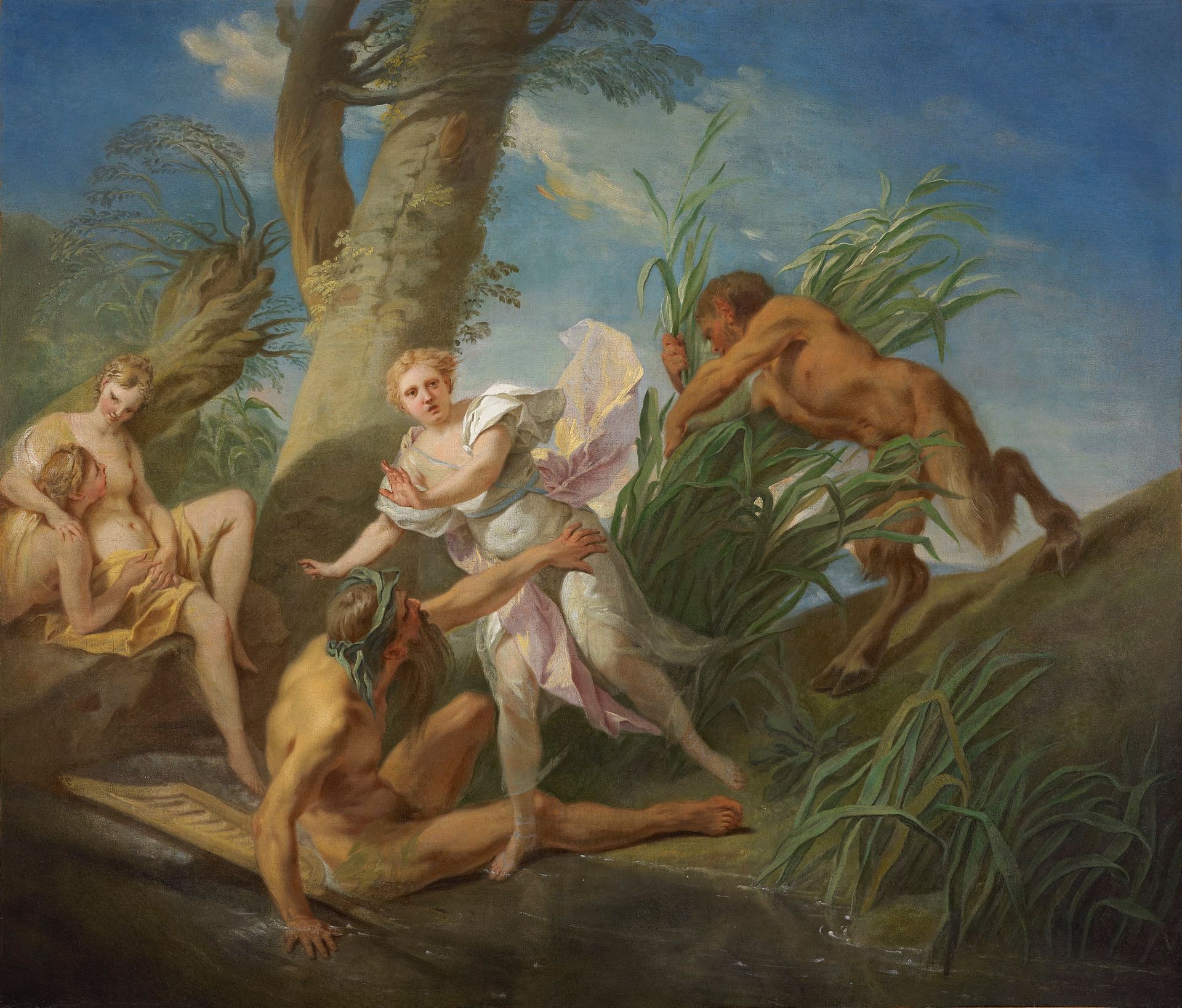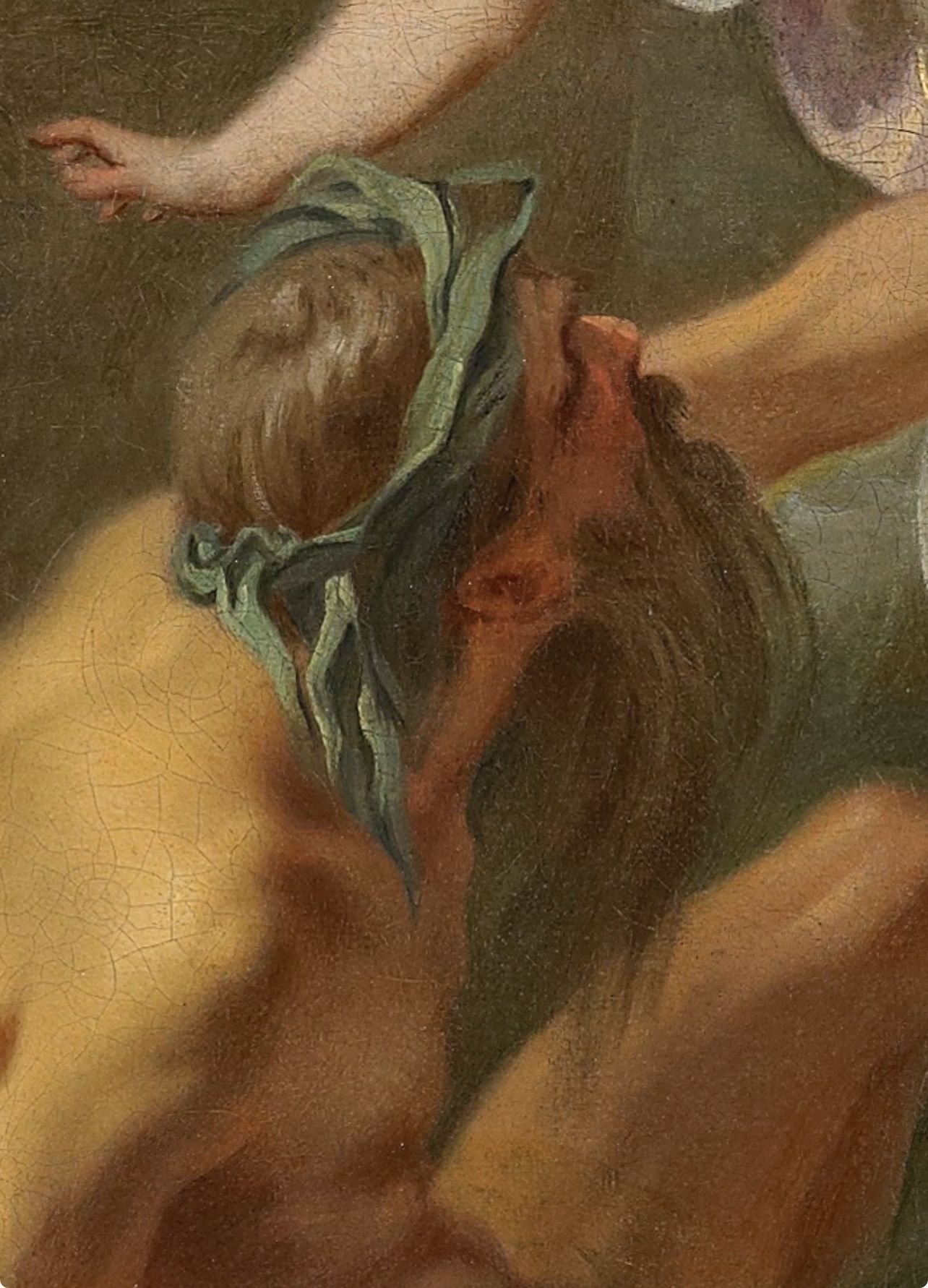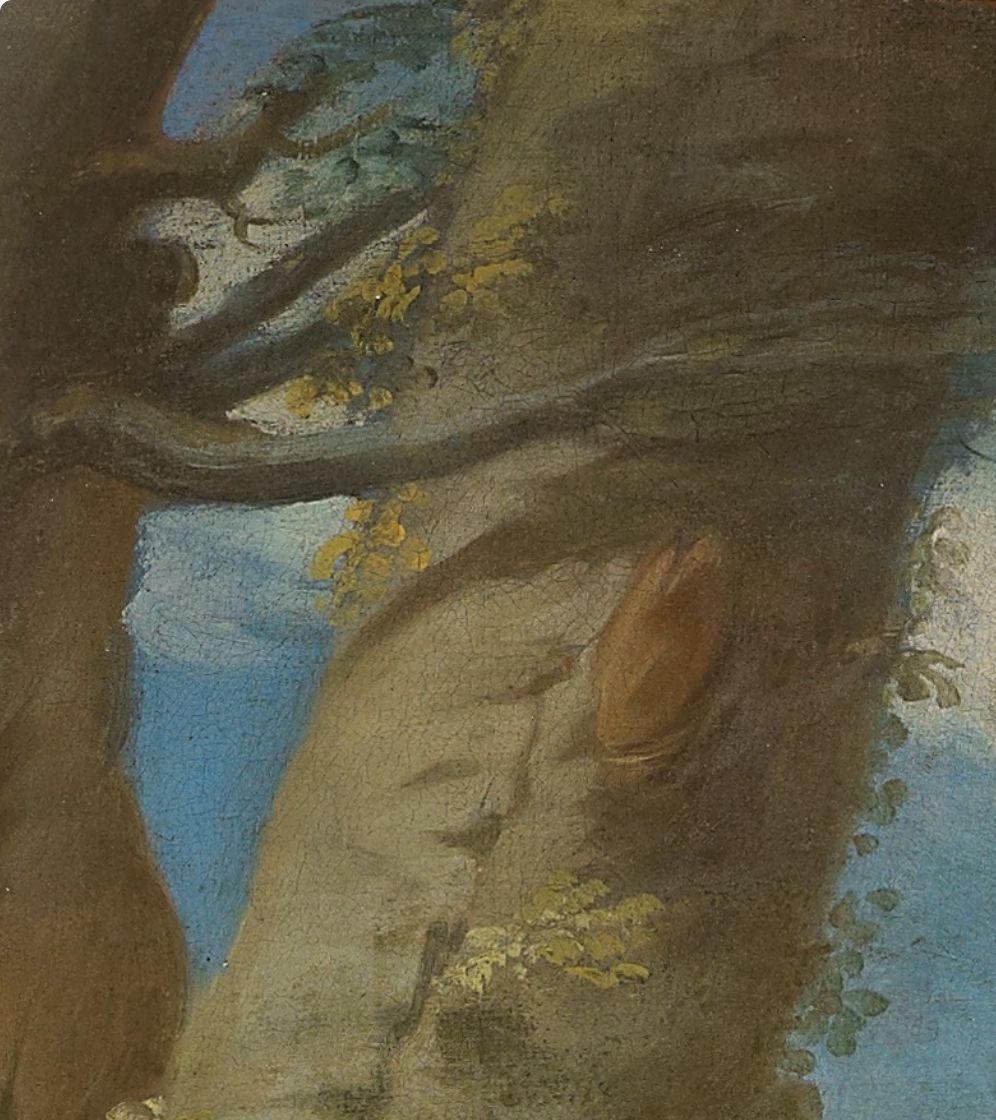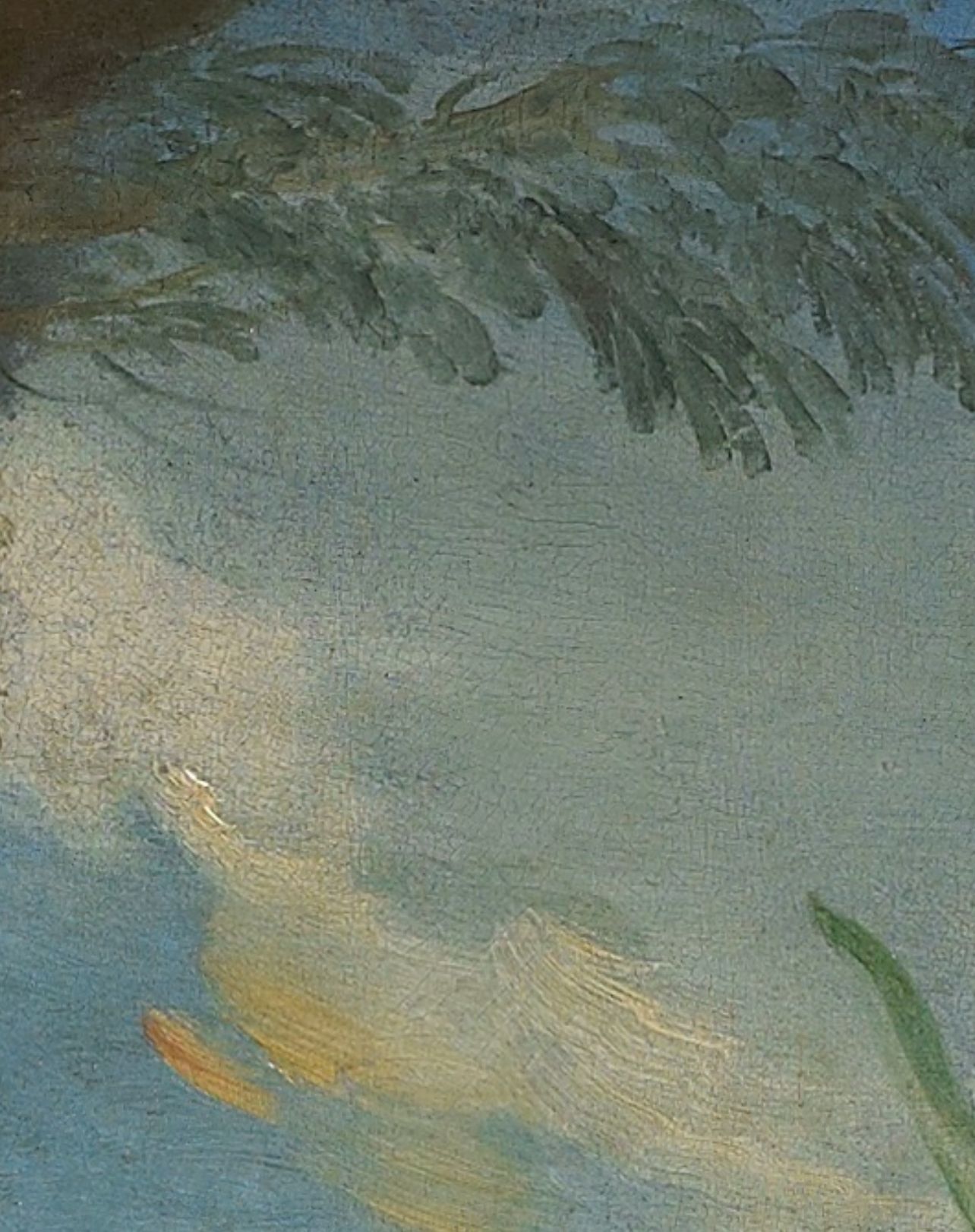
Jean-Baptiste Van LOO (Aix-en-Provence, 1684 – 1745)
Pan and Syrinx
Oil on scrolled canvas, placed after the rectangle, 115 x 133.7 cm
PROVENANCE
- Probably sale George Michael Moser, London (Hutchins), May 19-21, 1783, n°54 (Vanloo, Syrinx and Pan, in oil);
- Private collection in Southern Germany until March 2012 (like François Boucher).
THE ARTIST
Although most of his early works are unidentified or lost, we have sufficient documentation to know that over the course of his career, Jean-Baptiste's work varied between decorative, mythological, religious painting and the portrait. Dézallier D'Argenville and Dandré-Bardon both claim that he was introduced to the art of painting by his father Louis Van Loo (Amsterdam, 1652-Nice, 1712) in Toulon when he was 8 years old. It was in 1692, when Louis and his brother Jean (Amsterdam, 1654 - ?) were working for the French Navy, decorating the interiors of royal ships with mythological scenes of the gods' amorous adventures, landscapes, ornaments and decorations. 'Other reasons. These ships being real "floating castles" intended to spread the glory of the Sun King through their opulence, the drawings of the images were made by Jean Bérain (Lorrain, 1640 - Paris, 1711), the official painter of the Chamber and the Cabinet of the Roi, and the Van Loos were responsible for executing the actual paintings. They are known to have been thus employed between their voyages to the South and the Mediterranean islands from 1682 until the mid-1790s. Throughout this period they were also busy producing altarpieces for religious institutions wherever they went. , and probably portraits. Jean-Baptiste Van Loo himself was directly employed by the Navy in Toulon from 1705 to 1707 painting ships and decorating buildings such as the naval hospital, as well as producing religious paintings for local churches.
However, his first known major independent mythological program is the ceilings of the dome and the grand salon of the Pavillon Lenfant in Aix-en-Provence, painted in 1711-1712, which represent the stories of the sons of Zeus, Hermes and Apollo. Above the double spiral stairwell unfolds the story of Hermes, god of commerce, wealth, luck, fertility, herds, sleep, language, thieves and travelers, and inventor of instruments including the lyre and the syrinx. It is in this context that the "syrinx" appears for the first time in his work, to our knowledge; it was an instrument made from tubes glued together invented for his own amusement during a trick played on his brother Apollo. Above the large living room you can see the story of Apollo.
Made ten years earlier than the painting
Pan and Syrinx, this ceiling decoration shows a striking similarity in the design of shapes, types of figures and movement, they are obviously by the same hand.
RELATED WORK
The counterpart of our painting representing a
Diana and Endymion, in its original scrolled format, 112.5 x 132 cm, was sold by the François Heim gallery as “Carle VANLOO” to Barbara Johnson in July 1978. Ours was slightly enlarged on the occasion of its rectification, but its original dimensions and its scrolled format are strictly identical to those of Heim's painting (fig. 1).
FIG.1.
THE WORK
The painting that we present is a rare testimony to the art of the painter-academician Jean-Baptiste Vanloo, born in Aix-en-Provence in 1684 and died in the same city in 1745. The work of Jean-Baptiste Vanloo has in This effect was obscured by the particularly abundant production of his little brother, Carle Vanloo (1705-1765). In addition, the success of Jean-Baptiste Vanloo led him to lead an itinerant career in Turin, Rome, Paris, London, and Aix-en-Provence, which, paradoxically, disseminated his work and undermined the memory of his name. (on this question, see F. Marandet, “Jean-Baptiste Vanloo (1684-1745): his draftsmanship elucidated”, Master Drawings, fall 2020, pp. 343-364). Jean-Baptiste Vanloo devoted a good part of his activities to the art of portraiture, particularly during his stay in London between 1737 and 1742, and this also explains the lasting forgetting of his work as a history painter. However, there are certain points of reference, starting with The Flagellation commissioned in 1714 for the Roman church of Santa Maria in Monticelli (in situ, known by a reduction in the art trade in 2019) and The Handing Over of the Keys to Saint Peter, signed and dated 1716, which adorns the chapel of the royal palace in Turin (in situ). The consecutive Parisian period, going from 1719 to 1737, was marked by the creation, in 1721, of the Triumph of Galatea (Hermitage Museum), painting which could have constituted Jean-Baptiste Vanloo's reception piece if the Prince of Carignan had not wanted to keep it for himself. As we have demonstrated (Marandet, op. cit. p. 346), the exposure of Rest of Diana after the Hunt at the Salon des académiciens of 1737 is misleading because it long led people to believe that the painting dated from that year. Today at the Toulon Museum (fig. 2), this painting would in fact have been painted much earlier, perhaps before 1720.
FIG. 2. © Toulon, Museum of Fine Arts
The other crucial point of reference remains Renaud and Armide, painting kept at the Museum of Fine Arts of Angers (fig. 3). The history of this painting is closely linked to the activities of the merchant-restorer Joseph-Ferdinand Godefroid, himself a friend of Jean-Baptiste Vanloo, who bought the paintings of the Count of Morville to resell them to Robert Walpole, Prime Minister of Kings George 1st and George II of England (see F. Marandet, “From Paris to Houghton Hall, the circuit of the paintings of the Count of Morville”, La Revue de l'Art, June 2011, p. 31-37). During his stay in London, one of the most prestigious commissions received by Jean-Baptiste Vanloo was precisely the portrait of Robert Walpole. But above all, Renaud and Armide was conceived as a pendant to The Rape of Europa by Noël-Nicolas Coypel, the most important contemporary French painting belonging to the Count of Morville (now in the Philadelphia Museum). Knowing that Coypel's painting, painted for the famous competition of 1727, was acquired by the Count of Morville at the end of it, there is reason to imagine that the pendant was painted immediately, especially that the Count of Morille died shortly after, in 1732. However, our table has every chance of being located, chronologically speaking, between Diana's Rest And Renaud and Armide. The nymph seated on the left, the silhouette of the old willow which closes the scene, and the body of water between the spectator and the different figures are all motifs that we find in our painting and the composition of the Toulon Museum. On the other hand, the effect of golden light and the reduced scale of the figures tend to distance them a little in time. To be carefully considered Renaud and Armide, this time we notice other analogies with our table. Jean-Baptiste Vanloo reused the process of the body of water placed between the stage and us, but the scale of the figures this time is much closer to that of Pan and Syrinx. In addition, the more eventful dimension brings the two paintings together more closely. In one, Syrinx flees Pan's attacks, while in the other, the cupids flutter and flutter around the lovers. In addition to the silvery appearance of the draperies, we note additional analogies and in particular the nymph with the “lost profile” who leans on her folded right arm: in our painting, she points at the two protagonists; in the Angers painting, she again witnesses the scene based on the idea of desire. Another common point, the oblique tree with its very voluminous trunk: clearly visible in Pan and Syrinx, it resurfaces in the Armide garden, and we once again notice the detail of the small evocative touches of ivy on the surface of the trunk. To this bundle of clues, which suggests that our painting is placed around 1725, we will add one last: the existence of a painting by Vanloo representing Pan and Syrinx, in a London sale dating back to 1783 (see our provenance section). Given Jean-Baptiste Vanloo's stay in London, the painting is likely to have come from him rather than Carle, whose works were hardly distributed in England. The identification of this testimony by Jean-Baptiste Vanloo not only allows us to rediscover his little-known work as a history painter. It also shows Carle Vanloo's debt to his older brother: his very first paintings produced in the second half of the 1720s – we think of the Bathsheba preserved at the Bossuet Museum, in Meaux – are largely dependent on the motifs of Jean-Baptiste Vanloo. The discreet participation of Carle Vanloo in the works of his brother, at that time, is not completely excluded.
FIG. 3. © Angers, Museum of Fine Arts
The Van Loos and the Academy emphasized the importance of drawing in learning to paint. From 1720 to 1723, the period during which Jean-Baptiste painted Pan and Syrinx, Carle was between 15 and 17 years old. It is therefore not surprising to find at the Museum of Decorative Arts in Paris a signed but undated drawing by Carle representing Pan and Syrinx (fig. 4), which constitutes a work of art in its own right. It is also not surprising that Louis Michel Van Loo's earliest known history paintings feature a similar treatment of figures and action, notably in his 1725 Prix de Rome winning painting, Moses trampling Pharaoh's crown (current location unknown) and its reception piece, Apollo pursuing Daphne (Paris, ENSBA) ( fig. 5).
FIG. 4. © Paris, Museum of Decorative Arts
FIG. 5. © Paris, ENSBA
PHOTOGRAPHS' DETAILS














